
Olga Tobreluts
In 1989 Olga Tobreluts graduated from the Industrial College of building materials and details (Leningrad), Department of architecture. In the same year she entered GASU (State University of architecture and civil engineering) at the faculty of architecture. In 1992-1994 she studied at ART + COM (Berlin) at the Department of computer graphics and animation.
In 1991 she founded a laboratory for the study of Ornament at the Leningrad society "A-Z".In 1998-2000, she opened the Center for the art of Photography in the Youth house of Petrogradsky district of St. Petersburg.
The starting point in the artist's work was the participation in the exhibition of New Artists at the Leningrad Palace bridge in 1989, where Olga Tobreluts showed their abstract paintings. In 1994, Olga Tobreluts joined the circle of artists Of the new Academy of Fine Arts, founded by Timur Novikov. After studying in Berlin, the artist radically changes her style, ceases to engage in painting and goes headlong into computer graphics, combined with photography and 3D-models. In 1995 Tobreluts won the first prize "Videovision "at the festival "Third reality" in St. Petersburg (video"Woe from Wit"). 1998-prize "the Best European computer graphics" at THE griffelkunst festival (together with the artist Orlan), Hamburg, Germany. In 2000, O. Tobreluts entered the top ten winners of the international competition of media institutions (Taiwan).
In 2000 Olga started work on a grandiose project – a series of 54 works "Caesar and Galilean" on the drama of the same name by Heinrich Ibsen, which was exhibited at Henie Onstad Museum in Oslo, and then at the Russian Museum in St. Petersburg.
Since 2003 Olga almost completely stops working with the computer and returns to painting.
In 2016, she was elected to the honorary academies of the Russian Academy of Arts.
In 1989 Olga Tobreluts graduated from the Industrial College of building materials and details (Leningrad), Department of architecture. In the same year she entered GASU (State University of architecture and civil engineering) at the faculty of architecture. In 1992-1994 she studied at ART + COM (Berlin) at the Department of computer graphics and animation.
In 1991 she founded a laboratory for the study of Ornament at the Leningrad society "a-Ya".In 1998-2000, she opened the Center for the art of Photography in the Youth house of Petrogradsky district of St. Petersburg.
The starting point in the artist's work was the participation in the exhibition of New Artists at the Leningrad Palace bridge in 1989, where Olga Tobreluts showed their abstract paintings. In 1994, Olga Tobreluts joined the circle of artists Of the new Academy of Fine Arts, founded by Timur Novikov. After studying in Berlin, the artist radically changes her style, ceases to engage in painting and goes headlong into computer graphics, combined with photography and 3D-models. In 1995 Tobreluts won the first prize "Videovision "at the festival "Third reality" in St. Petersburg (video"Woe from Wit"). 1998-prize "the Best European computer graphics" at THE griffelkunst festival (together with the artist Orlan), Hamburg, Germany. In 2000, O. Tobreluts entered the top ten winners of the international competition of media institutions (Taiwan).
In 2000 Olga started work on a grandiose project – a series of 54 works "Caesar and Galilean" on the drama of the same name by Heinrich Ibsen, which was exhibited at Henie Onstad Museum in Oslo, and then at the Russian Museum in St. Petersburg.
Since 2003 Olga almost completely stops working with the computer and returns to painting.
In 2016, she was elected to the honorary academies of the Russian Academy of Arts.
Lives and works in St. Petersburg.
Photos of the works are provided by Ural Vision Gallery.

Olga Tobreluts. Red Dog, 2012, oil on canvas, 200 x 300 cm. Private collection

Olga Tobreluts. A Prisoner In The Caucasus, 2007, oil on canvas, 180 x 140 cm. Courtesy of the State Tretyakov gallery
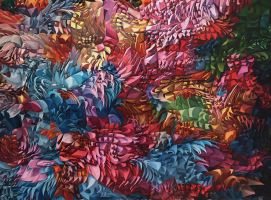
Olga Tobreluts. New Opportunities, 2016, oil on canvas, 200 x 300 cm. Courtesy of the Author
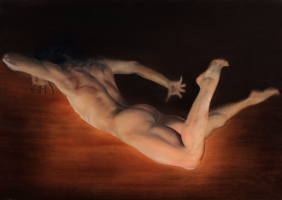
Olga Tobreluts. Icarus, 2011, oil on canvas, 95 x134 cm, private collection
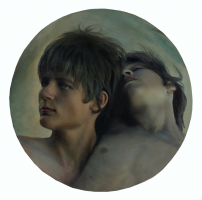
Olga Tobreluts. Apollo and Cyparissus, 2011, oil on canvas, D 98 cm, Courtesy of V. Bondarenko
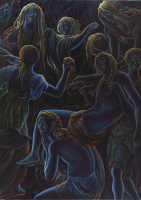
Olga Tobreluts. Pieta, 2011, oil on canvas, 140 x 100 cm, Courtesy of V. Bondarenko

Olga Tobreluts. Heart, 2014, oil on canvas, 150 x 150 cm. Courtesy of the Author

Olga Tobreluts. Modernization, Triptych, part 1, 2010, oil on canvas, 150 x 170 cm. Courtesy of MMOMA

Olga Tobreluts. Modernization, Triptych, part 3, 2010, oil on canvas, 150 x 170 cm. Courtesy of MMOMA
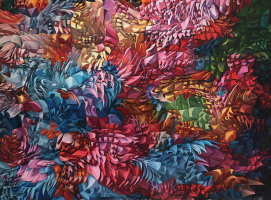
Olga Tobreluts. New Opportunities, 2016, oil on canvas, 200 x 300 cm. Courtesy of the Author
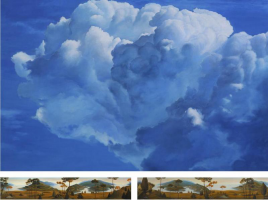
Olga Tobreluts. From the series "Sky landscapes", tryptich, oil on canvas, upper part 140 x 210 cm, lower parts gesso, 25 x 100 cm each
Selected Exhibitions
1994 — Feast of Hercules. Gallo-Roman museum. Brussels, Belgium
1995 — Imperial Reflections. Aidan Gallery. Moscow, Russia
1996 — Personal exhibition. Museum of the New Academy of Fine Arts. Saint Petersburg, Russia
1997 — Models. Art Kiosk Gallery. Brussels, Belgium
1998 — Family Portrait. Sigraph. New York, the USA
1998 — Feast of Hercules. Gallo-Roman museum. Tonningen, Germany
1999 — Mixed Media. The State Russian Museum. Saint Petersburg, Russia
2000 — Sacred figures. Seljord Kunstforening. Seljord, Norway
2003 — Sacred figures. Orel Art Presenta Galleru. Paris, France
2003 — Emperor and Galilein. State Russian Museum. Saint Petersburg, Russia
2003 — Emperor and Galilein. Heine Ostand Museum. Oslo, Norway
2003 — Sacred figures. Art Kiosk Gallery. Brussels, Belgium
2005 — Sacred figures. Il Segno Del Tempo Gallery. Milan, Italy
2005 — Tarquin and Lucretia. Solo exhibition. D137 Gallery. Saint Petersburg, Russia
2009 — Triumph Gallery. Moscow, Russia
2012 — NEO-CLASSY at AP CONTEMPORARY. Sheung Wan, Hong Kong
2013 — New mythology. Мoscow Museum of Modern Art. Moscow, Russia
2014 — Landscapes of Heaven. Name Gallery. Saint Petersburg, Russia
2015 — New opportunities. Deborah Collton Gallery. Houston, the USA
2017 — New Mythology. Palace of Exhibitions (Mucsarnok). Budapest, Hungary
